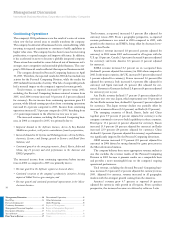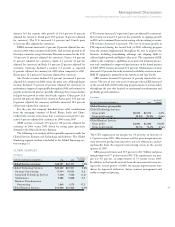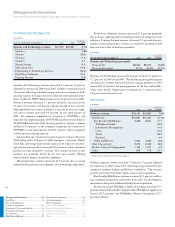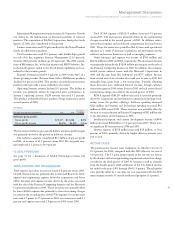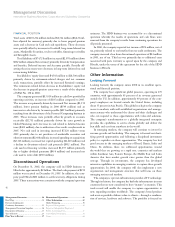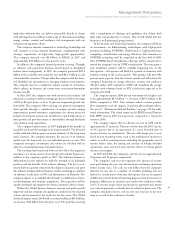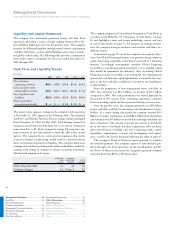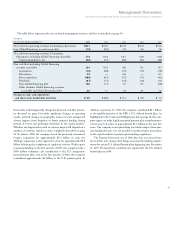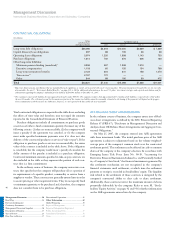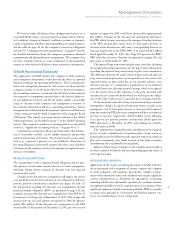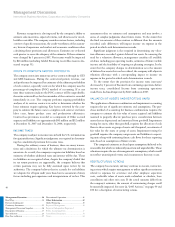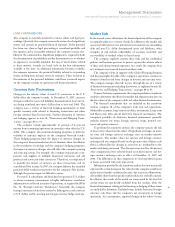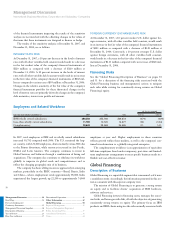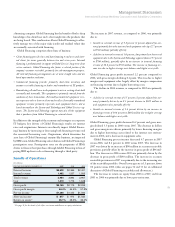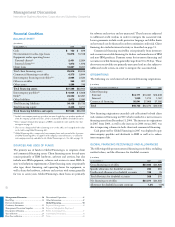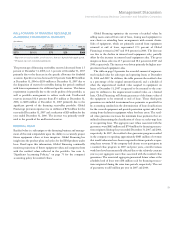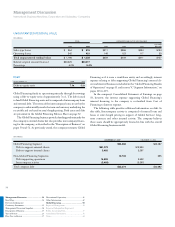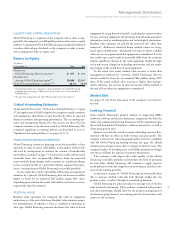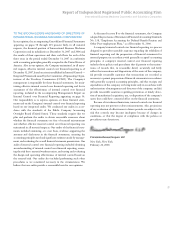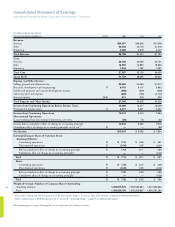IBM 2007 Annual Report Download - page 50
Download and view the complete annual report
Please find page 50 of the 2007 IBM annual report below. You can navigate through the pages in the report by either clicking on the pages listed below, or by using the keyword search tool below to find specific information within the annual report.
Management Discussion
International Business Machines Corporation and Subsidiary Companies
48
Revenue recognition is also impacted by the company’s ability to
estimate sales incentives, expected returns, and allowances for uncol-
lectible receivables. The company considers various factors, including
a review of specific transactions, the credit-worthiness of the custom-
ers, historical experience and market and economic conditions when
calculating these provisions and allowances. Estimates are evaluated
each quarter to assess the adequacy of the estimates. If these estimates
were changed by 5 percent in 2007, Net income would be impacted
by $46 million (excluding Global Financing receivables reserves dis-
cussed on page 55).
COSTS TO COMPLETE SERVICE CONTRACTS
The company enters into numerous service contracts through its GTS
and GBS businesses. During the contractual period, revenue, cost
and profits may be impacted by estimates of the ultimate profitability
of each contract, especially contracts for which the company uses the
percentage-of-completion (POC) method of accounting. If at any
time these estimates indicate the POC contract will be unprofitable,
the entire estimated loss for the remainder of the contract is recorded
immediately in cost. The company performs ongoing profitability
analyses of its services contracts in order to determine whether the
latest estimates require updating. Key factors reviewed by the com-
pany to estimate the future costs to complete each contract are future
labor costs, future product costs and productivity efficiencies.
Contract loss provisions recorded as a component of Other accrued
expenses and liabilities are approximately $41 million and $32 million
at December 31, 2007 and December 31, 2006, respectively.
INCOME TA XES
The company is subject to income taxes in both the U.S. and numerous
foreign jurisdictions. Significant judgments are required in determin-
ing the consolidated provision for income taxes.
During the ordinary course of business, there are many transac-
tions and calculations for which the ultimate tax determination is
uncertain. As a result, the company recognizes tax liabilities based on
estimates of whether additional taxes and interest will be due. These
tax liabilities are recognized when, despite the company’s belief that
its tax return positions are supportable, the company believes that
certain positions may not be fully sustained upon review by tax
authorities. The company believes that its accruals for tax liabilities
are adequate for all open audit years based on its assessment of many
factors including past experience and interpretations of tax law. This
assessment relies on estimates and assumptions and may involve a
series of complex judgments about future events. To the extent that
the final tax outcome of these matters is different than the amounts
recorded, such differences will impact income tax expense in the
period in which such determination is made.
Significant judgment is also required in determining any valua-
tion allowance recorded against deferred tax assets. In assessing the
need for a valuation allowance, management considers all available
evidence including past operating results, estimates of future taxable
income and the feasibility of ongoing tax planning strategies. In the
event that the company changes its determination as to the amount
of deferred tax assets that can be realized, the company will adjust its
valuation allowance with a corresponding impact to income tax
expense in the period in which such determination is made.
To the extent that the provision for income taxes increases/
decreases by 1 percent of Income from continuing operations before
income taxes, consolidated Income from continuing operations
would have declined/improved by $145 million in 2007.
VALUATION OF ASSETS AND REPORTING UNITS
The application of business combination and impairment accounting
requires the use of significant estimates and assumptions. The pur-
chase method of accounting for business combinations requires the
company to estimate the fair value of assets acquired and liabilities
assumed to properly allocate purchase price consideration between
assets that are depreciated and amortized from goodwill. Impairment
testing for assets, other than goodwill, requires the allocation of cash
flows to those assets or group of assets and if required, an estimate of
fair value for the assets or group of assets. Impairment testing for
goodwill requires the company assign assets and liabilities to report-
ing units along with estimating future cash flows for those reporting
units based on assumptions of future events.
The company’s estimates are based upon assumptions believed to be
reasonable, but which are inherently uncertain and unpredictable. These
valuations require the use of management’s assumptions, which would
not reflect unanticipated events and circumstances that may occur.
RESTRUCTURING ACTIONS
The company has executed, and may continue to execute, restructur-
ing actions which require management to utilize significant estimates
related to expenses for severance and other employee separation
costs, realizable values of assets made redundant or obsolete, lease
cancellation and other exit costs. If the actual amounts differ from
the company’s estimates, the amount of restructuring charges could
be materially impacted. See note Q, “2005 Actions,” on pages 99 and
100 for a description of restructuring actions.
Management Discussion ............................ 14
Road Map .........................................................14
Forward-Looking and
Cautionary Statements .....................................15
Management Discussion Snapshot ..................16
Description of Business ....................................17
Year in Review ..................................................23
Prior Year in Review ........................................37
Discontinued Operations .................................42
Other Information...................................... 42
Global Financing ..............................................50
Report of Management ....................................56
Report of Independent Registered
Public Accounting Firm ...................................57
Consolidated Statements ..................................58
Notes .................................................................64


